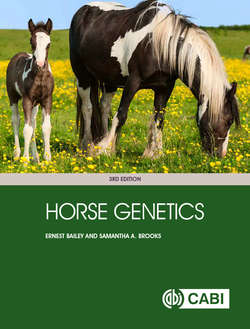Читать книгу Horse Genetics - Ernest Bailey - Страница 71
На сайте Литреса книга снята с продажи.
Practices for the Naming of Genes
ОглавлениеThe terminology used to name genes can be confusing and the reader needs to be wary. There is no single authority on how to name genes and alleles for animals. On one hand, it would seem appropriate to use the nomenclature established in the original publication for these genes and alleles. However, for a variety of good reasons, the original nomenclature may need to be abandoned in the name of creating clarity. There are some consistent practices. For example, The names of genes and loci are always italicized. However, other conventions have diverged.
At one time the practice was to always identify the locus with a single or a few letters (A, B, C, etc.) then represent the allele in superscript. For example, the Extension locus was represented by the letter E. Dominant alleles at that locus would be represented using capital letters in superscript, e.g. the dominant allele for black pigment was represented by EE. The recessive alleles were represented by lowercase letters, e.g. the recessive allele for red color at the Extension locus was represented as Ee. Recently, the practice of using superscripts has slowly been phased out. Superscripts were difficult to reproduce on some early printers and alleles were also more readily confused by readers because of the small print. The distinctions between some uppercase and lowercase letters were especially difficult to discern when using superscripts; an example is WW (White) versus Ww (non-White). Therefore, modern conventions dropped the superscript, instead representing the allele full sized, on the line just after the gene, and in italics. However, the practice is not universal. There is no committee standard for the nomenclature of horse genes.
With the advances brought by molecular genetics, we have come to realize that most genes have homologues among closely related species (e.g. all mammals). A gene discovered in one species has a counterpart in another and we adopt nomenclature that reflects this comparative genetic homology. Therefore one practice has been to follow the rules of the HUGO Human Gene Nomenclature Committee (https://www.genenames.org/) in assigning names to newly characterized genes. Again, there is no central authority to enforce these rules, nevertheless, the editorial policy of some scientific journals states that names must conform with them. These rules completely eschew the use of superscripts for naming alleles.
In many cases, laboratories offering commercial testing services have adopted nomenclature with the goal of creating clarity. Some companies offering testing for the HYPP variant causing a disease in Quarter horses refer to the two alleles as N for normal and D for disease.
Some writers may change the nomenclature used in an effort to increase clarity for the reader. While this may work in the short term, it may equally cause problems when readers compare different papers from different writers. For example, the gene for non-dilution at the Cream dilution locus has been represented by different authors as C, Cwt, C+, and N. (For the record, we are referring to that allele as cr.) At this point, there is no internationally recognized naming convention for horse coat color genes. In this text, we use the convention of representing alleles without superscripts except where the only published representation is with a superscript. For example, in Chapter 8, we describe the alleles of the Cream locus (C) as CR and cr rather than CCR and Ccr. However, two new alleles at the C locus, Pearl and Sunshine, were reported and published as Cprl (Holl et al., 2019; Sevane et al., 2019) and Csun (Holl et al., 2019) respectively. However, we have chosen to follow the practice of avoiding superscripts and using upper and lower case to represent dominant and recessive alleles, respectively. Therefore, in Chapter 8 we use the symbols prl and sun.
With the advent of molecular genetics, it has been possible to identify the DNA sequence and actual gene responsible for the trait of black or red color. In Chapter 4, the Extension locus is described as containing the gene Melanocortin-1 Receptor (MC1R). The precise DNA changes responsible for alleles at this locus are known and we could represent the alleles in a format reflecting the DNA strand or the changes in amino acids for the MC1R protein. However, it has been simpler and easier to continue using the conventional nomenclature of the Extension locus when referring to this gene in the context of coat color genetics. This is true with most of the other genes which had been identified and named before the discovery of the underlying molecular genetics.
